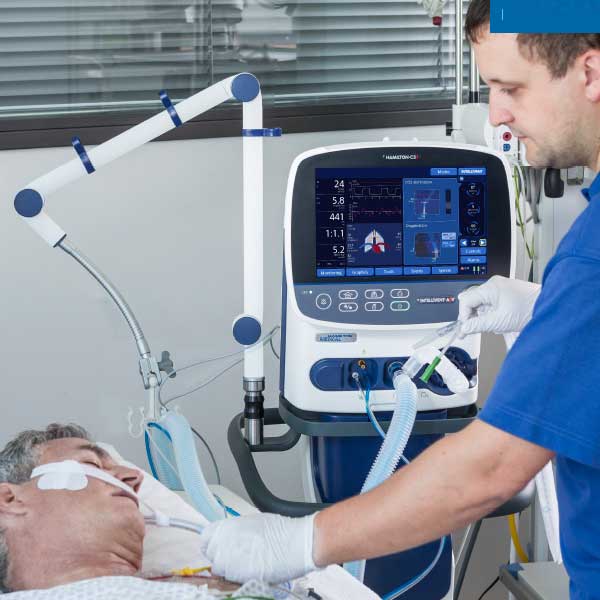
Ventilator Device
Respiratory support therapy is necessary when it comes to the safe maintenance of breathing during surgery or the treatment of a serious lung disease or other condition that affects normal breathing. In cases where respiratory support is needed, breathing can be supported with a device called a ventilator.
What is a ventilator?
The ventilator is a respiratory support device. A ventilator may be used during surgery or when treating a serious lung disease or other condition that affects normal breathing. The ventilator is mostly used in hospitals but sometimes in the home environment as well.
ventilator; It is also called a mechanical ventilator, respirator, respirator or artificial respirator.
How long does respiratory support with ventilator continue?
After the operation, when the patient is able to breathe adequately, there is no need for a ventilator.
But some people may need ventilators for very long periods of time, or perhaps for their entire remaining life. In such cases, ventilators can be used outside the hospital – in nursing homes or even at home.
The ventilator does not cure the disease or condition, except for certain special conditions, they are only used for life support.
What Are the Risks of Being on a Ventilator?
Infections
One of the most serious and common risks of being on a ventilator is pneumonia (lung infection). The tube placed in the trachea can facilitate the entry of bacteria into the lungs. As a result, Ventilator-Associated Pneumonia (VAP) may develop. A breathing tube may make coughing difficult, and some medications may suppress coughing. Coughing is a reflex that clears the airways of substances that are irritating to the lungs and cause infection.
Ventilator-Associated Pneumonia is already a major concern for ventilated patients, who are often critically ill. Pneumonia can also complicate the treatment of other diseases of the patient. VAP is treated with antibiotics. In patients who develop VAP, samples taken from the secretions in the airways are subjected to microbiological examination with aspiration or sometimes with a bronchoscope. In the event that bacteria that do not respond to standard antibiotics are identified, the antibiotics that are resistant and sensitive to which antibiotics are determined by the antibiogram, and antibiotic treatments are arranged with the recommendations of the infectious diseases specialists.
Another risk for the ventilator-dependent patient is sinus infections. Sinus infections, especially seen in patients who have been intubated through the nose, can also be seen in patients who have a tube inserted through the mouth. For this reason, a tracheostomy tube is placed in the very early period when it is predicted that the ventilator therapy will take a long time, and when the duration is prolonged even if it is unpredictable. Sinus infections are also treated with antibiotics.
The patient on the ventilator is also at risk for other problems:
Pneumothorax: It is the leakage of air from the lungs into the space between the lung and the chest wall. It can cause pain and shortness of breath. It can cause one or sometimes both lungs to contract. It can put pressure on the heart.
Lung damage: Introducing air to the lungs with very high pressure can cause damage to the lungs.
Oxygen toxicity: High concentrations of oxygen can also cause damage to the lungs.
The patient on the ventilator is also at risk of blood clots and serious skin infections. These problems are more common in certain diseases (diabetes, vascular diseases). These problems are more common in patients who are bedridden, stay in a certain position in bed or in a wheelchair for a long time.
What Does a Respiratory Support Device (Ventilator) Do?
Respiratory support device/ventilators;
They provide respiration in people who have lost the ability to breathe on their own.
They carry oxygen to the lungs.
They remove carbon dioxide from the body (carbon dioxide is a waste gas that can also be toxic).
They allow patients to breathe easier.
Who Needs a Respiratory Support Device (Ventilator)?
Ventilators are most commonly used in patients under general anesthesia during surgery. Sleeping drugs used to create anesthesia, strong painkillers and drugs that provide muscle relaxation affect the respiratory system. Therefore, a ventilator is used to support respiration.
In addition, when lung functions are impaired as a result of a disease or condition, it may be necessary to support breathing with a ventilator.
Why is Respiratory Support (Mechanical Ventilation) Necessary in Surgery?
General anesthesia provides temporary sleep in surgeries, and drugs used for sleep may also disrupt normal breathing. For this reason, it is necessary to apply respiratory support therapy with a ventilator in surgeries.
A patient receiving general anesthesia during surgery is likely to be connected to a ventilator. Medications used to initiate anesthesia can stop normal breathing. The ventilator helps maintain breathing (artificial respiration) during surgery. am




